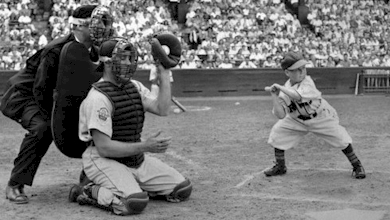 As baseball looks at getting started again, it seems like a good to talk about the time when Major League Baseball became Little League Baseball. Ok, not exactly, but nevertheless, little league it was to a certain degree. The year was 1951, and the Saint Louis Browns were sporting their smallest player in history…probably in the history of baseball. His name was Edward Carl “Eddie” Gaedel, and he stood just 3 feet 7 inches tall. He weighed 65 pounds. Gaedel was born on June 8, 1925, in Chicago. He was the second of the three children of Carl and Helen Gaedel. Carl Gaedel was born in Lithuania and immigrated to the United States in 1902, settling in Chicago before starting his family. The family name may have been changed to Gaedel from Gaedele at the time of his immigration.
As baseball looks at getting started again, it seems like a good to talk about the time when Major League Baseball became Little League Baseball. Ok, not exactly, but nevertheless, little league it was to a certain degree. The year was 1951, and the Saint Louis Browns were sporting their smallest player in history…probably in the history of baseball. His name was Edward Carl “Eddie” Gaedel, and he stood just 3 feet 7 inches tall. He weighed 65 pounds. Gaedel was born on June 8, 1925, in Chicago. He was the second of the three children of Carl and Helen Gaedel. Carl Gaedel was born in Lithuania and immigrated to the United States in 1902, settling in Chicago before starting his family. The family name may have been changed to Gaedel from Gaedele at the time of his immigration.
Gaedel was the smallest player ever to appear in a Major League Baseball game. He gained recognition in the second game of a Saint Louis Browns doubleheader on August 19, 1951. Gaedel’s major league career was shorter than he was in the end. He made a single plate appearance and was walked with four consecutive balls before being replaced by a pinch-runner at first base. Nevertheless, his jersey, bearing the uniform number “?1?8,” is displayed in the Saint Louis Cardinals Baseball Hall of Fame and Museum. Sometimes, it isn’t the length of the career that matters, But rather it is what makes the career unique that really matters. Never before had the major leagues had such a player. It was like putting a child on the major leagues, except that he could play…at least well enough to be chosen to play on the Saint Louis Browns in the first place. The world will never know if he could have been great, because he only played the one time.
Gaedel was well liked. The Saint Louis Browns owner, Bill Veeck said of Gaedel in his 1962 autobiography said, “He was, by golly, the best darn midget who ever played big-league ball. He was also the only one.” Both statements were true, and Gaedel would go down in history as the midget who combined the Major League with the Little League.
Prior to his career in baseball, and due to his size, Gaedel had worked as a riveter during World War II. He was unique in his job, because he was able to crawl inside the wings of airplanes. He was also a professional performer, belonging to the American Guild of Variety Artists (AGVA). After the war, Gaedel was hired in 1946 by Mercury Records as a mascot to portray the “Mercury Man.” He sported a winged hat similar to the record label’s logo, to promote Mercury recordings. Some of the early Mercury recordings featured a caricature of him as its logo. Then, the Browns’ owner Bill Veeck, who liked a little bit of the outrageous, and a showman who enjoyed staging publicity stunts, found Gaedel through a booking agency. He secretly signed him to the Browns, he was added to the team roster and put in uniform…with the number “?1?8” on the back. The uniform belonged to current Saint Louis Cardinals managing partner and chairman William DeWitt, Jr. who was a 9 year old batboy for the Browns at the time. It may have been a stunt, but it made Eddie Gaedel famous.
Unfortunately, after his baseball career ended, things did not go well for Gaedel. On June 18, 1961, and having just turned 36, an unemployed Gaedel, was at a bowling alley in Chicago. Gaedel was followed home and beaten. His mother discovered Eddie lying dead in his bed. He had bruises about his knees and on the left side of his face. A coroner’s inquest determined that he also had suffered a heart attack. Bob Cain, who’d pitched to  Gaedel, was the only Major League Baseball figure to attend the funeral. Gaedel was buried at Saint Mary Catholic Cemetery and Mausoleum in Cook County, Illinois. His tombstone indicates that his family name may actually have been Gaedele, not Gaedel. The person or persons who killed Gaedel were never found. The police speculated that Gaedel, who had become known as a hot-head, probably got into an argument with someone at the bowling alley, and the person followed him and beat him. Because of Gaedel’s reputation, the Chicago Police Department declined to investigate the matter further. It was such a tragic end for a Baseball Hall of Famer.
Gaedel, was the only Major League Baseball figure to attend the funeral. Gaedel was buried at Saint Mary Catholic Cemetery and Mausoleum in Cook County, Illinois. His tombstone indicates that his family name may actually have been Gaedele, not Gaedel. The person or persons who killed Gaedel were never found. The police speculated that Gaedel, who had become known as a hot-head, probably got into an argument with someone at the bowling alley, and the person followed him and beat him. Because of Gaedel’s reputation, the Chicago Police Department declined to investigate the matter further. It was such a tragic end for a Baseball Hall of Famer.


Leave a Reply